FAQs about Ultrasonic Thickness Gauge
Can I measure through more than 6mm of coating?
There is a special feature called ‘Deep Coat’ that can allow Cygnus gauges to measure metal thickness through up to 20 mm of coating. Please contact Cygnus for details of how this feature can be enabled on certain gauges. Please note however the ability to measure through thick coatings depends entirely on the type of coating, we can not guarantee the gauge will measure through every type of coating.
Can I use non-Cygnus probes on my Cygnus gauge?
Only Cygnus probes should be used with Cygnus gauges. The specifications of Cygnus probes is carefully controlled to ensure optimum performance from your Cygnus gauge. Using non-Cygnus probes may cause incorrect or unsatisfactory operation.
Can the gauges be used on materials other than steel?
Yes. Although the majority of applications require the gauges to be used on steel, the gauges can be used on a variety of other materials by either entering the known velocity of sound into the gauge in metres per second, or by calibrating the gauge with a known thickness of the material under test. Typical examples include, aluminium, copper, grey cast iron, magnesium, nickel, stainless steel, tungsten, monel, inconel, phosphor bronze and brass.
Do I need to change the sound velocity on the gauge when measuring different materials?
Yes, otherwise an incorrect reading will be shown. To download the Velocity Table click here. These are also listed in the manual supplied with the gauge.
If only a few measurements are to be taken on a material other than Steel, it may be easier to leave the calibration set for Steel and convert the readings by multiplying by the Conversion Factor for the material being measured:
True Reading = Reading x Conversion Factor
Conversion factors are listed in the Velocity Table. This method avoids unnecessary re-calibration.
Does the gauge need to be calibrated? If so, how often?
All Cygnus gauges are calibrated for Steel when they are manufactured and the calibration can be adjusted to suit the type of material under test. Certificates of calibration are issued at the factory. The gauges can be returned for recalibration at the customer’s request and in accordance with their own quality requirements. This is usually every 12 months when the equipment can be tested, checked and recalibrated using equipment traceable to national standards.”
The European Standard BS EN 15317 ‘Characterization and verification of ultrasonic thickness measuring equipment’ recommends all gauges to be subject to an annual Performance Check to ensure correct operation. All new Cygnus gauges are manufactured in accordance with this standard.
How does Multiple Echo ultrasonic thickness gauging work?
You can download the Multiple-Echo Explanation sheet from ‘Technical Information‘.
I am having difficulty getting thickness readings?
Assuming the batteries are good the next thing to check is if the Probe Membrane is fitted correctly, has enough couplant behind it and is not damaged or worn. You can download the Probe Membrane Fitting Instructions sheet from ‘Technical Information‘ for more information.
A correctly fitted membrane is essential for optimum gauge operation
Gain Settings. Some Cygnus gauges have a Gain Setting in their menu:
- If the Gain in too low then getting readings will be difficult or impossible.
- If the Gain is too high then the gauge may display standing readings when the probe is not in contact with the material surface.
To correctly set the Gain follow these simple steps:
- Make sure the probe face is clear of couplant and is not touching any surface.
- Set the gain to a high value (i.e. 12).
- Observe the thickness display – If you see more than one flashing bar or a thickness value then reduce the gain by 1 and check the display again. Continue to reduce the gain until you see one flashing bar on the display.
- You now should have reduced the gain so the gauge is consistently displaying one flashing bar only.
- The Gain has now been correctly set.
How to install CygLink software on computers running Windows 10?
CygLink needs the .NET framework version 3.5 on computers running Windows 10.
Is Cygnus Data Logging software (CygLink) compatible with Windows 7?
Yes, the Cyglink application will work with all versions of Windows (XP and above, both 32 & 64 Bit versions).
However, the serial to USB converter may require the latest driver installing. You can download the latest drivers for the USB to Serial Converters from ‘Software Downloads‘. You will just need to register your details to access it.
The small grey USB to Serial Port Cable

The Black USB-485 Converter from KK Systems

What certification does Cygnus Instruments have?
The company has BS EN ISO 9001:2000 certification for the design, development, manufacture and repair of ultrasonic measuring equipment and associated accessories.
What make of batteries do you recommend?
Cygnus recommends Duracell Procell batteries for all gauges that require disposable batteries.
What product training do I need?
That will depend on your requirements. The operation of the Cygnus Instruments range of products is straightforward. Measurements can be taken by a competent operator with minimal training. If however you need to provide certified readings then you may need to have specific training to comply with your customers requirements.
What support does Cygnus offer once I've purchased my equipment?
Cygnus’ Product Support Policy is to aim to support all Cygnus products until 7 years after the date they are discontinued.
For example, when Cygnus introduced its new Mk5 surface gauges in April 2015, support for Mk4 surface gauges will end in April 2022.


